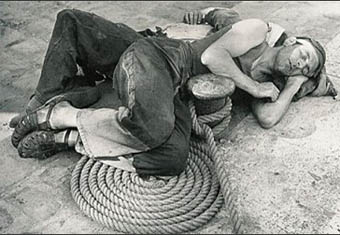This post is also available in:
 Anglais
Anglais
Willy Ronis parlait de « mise au purgatoire injuste » pour évoquer l’oubli dans lequel est cantonnée l’oeuvre de son ami Izis. Cité dans toutes les histoires de la photographie comme l’un des grands photographes humanistes, sélectionné dès 1951 avec Brassaï, Cartier-Bresson, Doisneau et Ronis pour l’exposition « Five French Photographers », au MoMA de New York, à la fois poète de l’image, portraitiste, reporter, Izis reste un artiste méconnu.
Souvent citée mais rarement montrée, son œuvre révèle la façon particulière qu’avait Izis d’appréhender la vie. Au réalisme du témoignage, lui qui se rêvait peintre, préférait la recomposition et la poétisation du monde.
Né Izraël Biderman le 17 janvier 1911 dans la Russie tsariste, renommé Izraëlis Bidermanas en 1918 dans la Lituanie devenue indépendante, il choisira un jour de s’appeler Izis.
Cette rétrospective est l’occasion de suivre le parcours de ce jeune Litvak élégant qui décida à dix-neuf ans de fuir la misère de son pays pour rejoindre le « Paris des rêves », capitale des peintres et des impressionnistes, et qui en 1944, à Limoges, se libéra des codes du studio pour effectuer une série de portraits de maquisards d’une saisissante modernité.
Viendront ensuite ses duos avec Jacques Prévert, Colette et Marc Chagall dont il tentera de percer le mystère de l’inspiration artistique, sa passion pour le cirque et la fête foraine et sa réinterprétation contemporaine de l’Israël biblique.
« J’appuie sur le déclic quand je suis à l’unisson avec ce que je vois », expliquait Izis qui sut concilier sa profession de reporter pendant vingt ans à Paris Match et son oeuvre personnelle.
« IZIS, THE PARIS OF DREAMS »
The exhibition “Izis, the Paris of Dreams” focuses primarily on the Parisian period the artist. The popular and sensual Paris, a post-war graphic. Willy Ronis used to speak of an “unfair purgatory” referring to the oblivion the work of his friend Izis was confined to. In every photography history he was cited as one of the greatest humanist photographers. He was also selected in 1951 with Brassai, Cartier-Bresson, Doisneau and Ronis for the exhibition “Five French Photographers” at the MoMA in New York: a poet of the image, a portrait painter, a reporter, but still an unknown artist. His work often cited but rarely showed, reveals how particular his way of understanding life was. His testimony was terribly real, but Izis, who dreamed to become a painter, preferred to “compose” and recount the world.Izrael Biderman, born January 17th 1911 in Czarist Russia, renamed Izraeli Bidermanas in 1918, when in Lithuania became independent, will soon choose to be called Izis.This retrospective is an opportunity to follow the path of this young elegant Litvak (Lithuanian Jew), who decided to escape the misery of his country at nineteen years old and join the “Paris of Dreams”: capital of painters and Impressionists. In 1944, Izis headed to Limoges, where he freed himself from the laws of the studio, and performed a series of portraits of maquisard (members of the Resistance during the German occupation) of a striking modernity. Later on came his duets with Jacques Prevert, Colette and Marc Chagall of whom he tried to reveal the mystery of artistic inspiration. His passion for the circus, the carnival and the contemporary reinterpretation of biblical Israel are also revealed in his work.
Du 20/01/2010 au 29/05/2010
Hôtel de ville
5, rue Lobeau
75004 Paris
France
Horaires : Entrée libre et gratuite de 10h à 19h, tous les jours sauf dimanche et fêtes
Téléphone : 39 75
www.paris.fr
NEWSLETTER
Pour recevoir nos informations, inscrivez votre adresse email.EN SAVOIR PLUS

Pour Que l’Esprit Vive,
Association loi 1901 reconnue d’utilité publique
Siège social
20 rue Lalande,
75014 Paris – France


